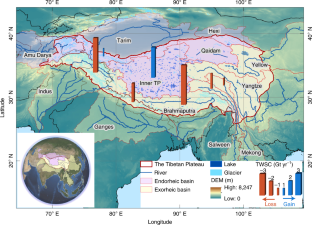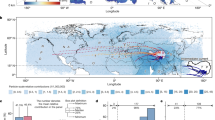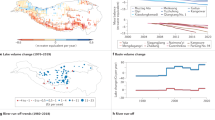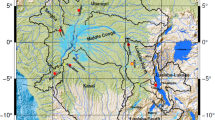Abstract
Terrestrial water storage (TWS) over the Tibetan Plateau, a major global water tower, is crucial in determining water transport and availability to a large downstream Asian population. Climate change impacts on historical and future TWS changes, however, are not well quantified. Here we used bottom-up and top-down approaches to quantify a significant TWS decrease (10.2 Gt yr–1) over the Tibetan Plateau in recent decades (2002–2017), reflecting competing effects of glacier retreat, lake expansion and subsurface water loss. Despite the weakened trends in projected TWS, it shows large declines under a mid-range carbon emissions scenario by the mid-twenty-first century. Excess water-loss projections for the Amu Darya and Indus basins present a critical water resource threat, indicating declines of 119% and 79% in water-supply capacity, respectively. Our study highlights these two hotspots as being at risk from climate change, informing adaptation strategies for these highly vulnerable regions.
This is a preview of subscription content, access via your institution
Access options
Access Nature and 54 other Nature Portfolio journals
Get Nature+, our best-value online-access subscription
$29.99 / 30 days
cancel any time
Subscribe to this journal
Receive 12 print issues and online access
$209.00 per year
only $17.42 per issue
Buy this article
- Purchase on Springer Link
- Instant access to full article PDF
Prices may be subject to local taxes which are calculated during checkout




Similar content being viewed by others
Data availability
Shapefiles of hydrologic basin boundaries63 used in this study are provided at http://data.tpdc.ac.cn. GRACE and GRACE-FO data are provided by the NASA MEaSUREs Program, where SH and JPL-M data can be accessed at https://grace.jpl.nasa.gov/; and the CSR-M data can be accessed at http://www2.csr.utexas.edu/grace. The elevation-change maps over the glacierized areas64 are provided at https://doi.org/10.1594/PANGAEA.876545, and RGI 6.0 glacier mask can be accessed at http://www.glims.org/RGI/. Datasets of lake storage changes46,65 are available at https://doi.org/10.5281/zenodo.5543615 and https://doi.org/10.1594/PANGAEA.898411. Data from GLDAS land surface models and IMERG precipitation can be accessed at https://disc.gsfc.nasa.gov/. ERA5 reanalysis data are available at https://cds.climate.copernicus.eu/. GLEAM ET data are available at https://www.gleam.eu/. Data from CMIP6 models can be found at https://esgf-node.llnl.gov/. Irrigation water demand is derived from the LPJml model provided by the ISIMIP portal (https://www.isimip.org/outputdata/). Industrial and domestic water demand is available on request from Y. Wada (wada@iiasa.ac.at). Monsoon monitor results for generating Supplementary Fig. 8 are derived at http://apdrc.soest.hawaii.edu/projects/monsoon/. Model-simulated TWS for generating Supplementary Fig. 10 is available at https://www.isimip.org/outputdata/. Reservoir information for generating Supplementary Fig. 18 can be accessed at https://globaldamwatch.org. Data for generating Supplementary Figs. 1, 6 and 11 are accessible on request from Y. Pokhrel (ypokhrel@egr.msu.edu), G. Zheng (zhengguanheng163@163.com) and Z. Sun (sunzhangli@gmail.com), respectively. Projected TWS changes by the mid-twenty-first century, generated by this study66, are available at https://doi.org/10.5281/zenodo.6784501.
Code availability
All analysis was performed using functions in MATLAB. The key portions of the computer code used to process the results and develop the figures67 are available at https://doi.org/10.5281/zenodo.6784641.
References
Yao, T. et al. The imbalance of the Asian water tower. Nat. Rev. Earth Environ. https://doi.org/10.1038/s43017-022-00299-4 (2022).
Yao, T. et al. Different glacier status with atmospheric circulations in Tibetan Plateau and surroundings. Nat. Clim. Change 2, 663–667 (2012).
Moelg, T., Maussion, F. & Scherer, D. Mid-latitude westerlies as a driver of glacier variability in monsoonal High Asia. Nat. Clim. Change 4, 68–73 (2014).
Tapley, B. D. et al. Contributions of GRACE to understanding climate change. Nat. Clim. Change 9, 358–369 (2019).
Kraaijenbrink, P. D. A., Bierkens, M. F. P., Lutz, A. F. & Immerzeel, W. W. Impact of a global temperature rise of 1.5 degrees Celsius on Asia’s glaciers. Nature 549, 257–260 (2017).
Houborg, R., Rodell, M., Li, B., Reichle, R. & Zaitchik, B. F. Drought indicators based on model-assimilated Gravity Recovery and Climate Experiment (GRACE) terrestrial water storage observations. Water Resour. Res. 48, W07525 (2012).
Long, D. et al. GRACE satellite monitoring of large depletion in water storage in response to the 2011 drought in Texas. Geophys. Res. Lett. 40, 3395–3401 (2013).
Long, D. et al. Drought and flood monitoring for a large karst plateau in Southwest China using extended GRACE data. Remote Sens. Environ. 155, 145–160 (2014).
Reager, J. T., Thomas, B. F. & Famiglietti, J. S. River basin flood potential inferred using GRACE gravity observations at several months lead time. Nat. Geosci. 7, 589–593. (2014).
Pokhrel, Y. N. et al. Model estimates of sea-level change due to anthropogenic impacts on terrestrial water storage. Nat. Geosci. 5, 389–392 (2012).
Jacob, T., Wahr, J., Pfeffer, W. T. & Swenson, S. Recent contributions of glaciers and ice caps to sea level rise. Nature 482, 514–518 (2012).
Immerzeel, W. W. et al. Importance and vulnerability of the world’s water towers. Nature 577, 364–369 (2020).
Scanlon, B. R. et al. Global models underestimate large decadal declining and rising water storage trends relative to GRACE satellite data. Proc. Natl Acad. Sci. USA 115, E1080–E1089 (2018).
Pokhrel, Y. N. et al. Incorporation of groundwater pumping in a global land surface model with the representation of human impacts. Water Resour. Res. 51, 78–96 (2015).
Pokhrel, Y. et al. Global terrestrial water storage and drought severity under climate change. Nat. Clim. Change 11, 226–233 (2021).
Brun, F., Berthier, E., Wagnon, P., Kaab, A. & Treichler, D. A spatially resolved estimate of High Mountain Asia glacier mass balances from 2000 to 2016. Nat. Geosci. 10, 668–673 (2017).
Zhao, F., Long, D., Li, X., Huang, Q. & Han, P. Rapid glacier mass loss in the Southeastern Tibetan Plateau since the year 2000 from satellite observations. Remote Sens. Environ. 270, 112853 (2022).
Farinotti, D., Immerzeel, W. W., de Kok, R. J., Quincey, D. J. & Dehecq, A. Manifestations and mechanisms of the Karakoram glacier anomaly. Nat. Geosci. 13, 8–16 (2020).
Forsythe, N., Fowler, H. J., Li, X.-F., Blenkinsop, S. & Pritchard, D. Karakoram temperature and glacial melt driven by regional atmospheric circulation variability. Nat. Clim. Change 7, 664–670 (2017).
Zhang, G. et al. Lake volume and groundwater storage variations in Tibetan Plateau’s endorheic basin. Geophys. Res. Lett. 44, 5550–5560 (2017).
Li, X. et al. High-temporal-resolution water level and storage change data sets for lakes on the Tibetan Plateau during 2000–2017 using multiple altimetric missions and Landsat-derived lake shoreline positions. Earth Syst. Sci. Data 11, 1603–1627 (2019).
Wang, T. et al. Permafrost thawing puts the frozen carbon at risk over the Tibetan Plateau. Sci. Adv. 6, eaaz3513 (2020).
Zheng, G. et al. Remote sensing spatiotemporal patterns of frozen soil and the environmental controls over the Tibetan Plateau during 2002–2016. Remote Sens. Environ. 247, 111927 (2020).
Rodell, M. et al. Emerging trends in global freshwater availability. Nature 557, 651–659 (2018).
Tapley, B. D., Bettadpur, S., Ries, J. C., Thompson, P. F. & Watkins, M. M. GRACE measurements of mass variability in the Earth system. Science 305, 503–505 (2004).
Jing, W., Zhang, P. & Zhao, X. A comparison of different GRACE solutions in terrestrial water storage trend estimation over Tibetan Plateau. Sci. Rep. 9, 1765 (2019).
Viviroli, D., Kummu, M., Meybeck, M., Kallio, M. & Wada, Y. Increasing dependence of lowland populations on mountain water resources. Nat. Sustain. 3, 917–928 (2020).
Zhang, G., Yao, T., Xie, H., Kang, S. & Lei, Y. Increased mass over the Tibetan Plateau: from lakes or glaciers? Geophys. Res. Lett. 40, 2125–2130 (2013).
Biemans, H. et al. Importance of snow and glacier meltwater for agriculture on the Indo–Gangetic Plain. Nat. Sustain. 2, 594–601 (2019).
Lutz, A. F. et al. South Asian agriculture increasingly dependent on meltwater and groundwater. Nat. Clim. Change 12, 566–573 (2022).
Gao, J., Yao, T., Masson-Delmotte, V., Steen-Larsen, H. C. & Wang, W. Collapsing glaciers threaten Asia’s water supplies. Nature 565, 19–21 (2019).
Liu, B. et al. Causes of the outburst of Zonag Lake in Hoh Xil,Tibetan Plateau, and its impact on surrounding environment. J. Glaciol. Geocryol. 38, 305–311 (2016).
Yao, X., Liu, S., Sun, M., Guo, W. & Zhang, X. Changes of Kusai Lake in Hoh Xil region and causes of its water overflowing. Acta Geogr. Sin. 67, 689–698 (2012).
Rounce, D. R., Hock, R. & Shean, D. E. Glacier mass change in High Mountain Asia through 2100 using the open-source Python Glacier Evolution Model (PyGEM). Front. Earth Sci. 7, 331 (2020).
Qin, Y. et al. Agricultural risks from changing snowmelt. Nat. Clim. Change 10, 459–465 (2020).
Jain, M. et al. Groundwater depletion will reduce cropping intensity in India. Sci. Adv. 7, eabd2849 (2021).
Murakami, D. & Yamagata, Y. Estimation of gridded population and GDP scenarios with spatially explicit statistical downscaling. Sustainability 11, 2106 (2019).
De Stefano, L., Petersen-Perlman, J. D., Sproles, E. A., Eynard, J. & Wolf, A. T. Assessment of transboundary river basins for potential hydro-political tensions. Glob. Environ. Change 45, 35–46 (2017).
Landerer, F. W. et al. Extending the global mass change data record: GRACE follow-on instrument and science data performance. Geophys. Res. Lett. 47, e2020GL088306 (2020).
Scanlon, B. R. et al. Global evaluation of new GRACE mascon products for hydrologic applications. Water Resour. Res. 52, 9412–9429 (2016).
Cleveland, R. B., Cleveland, W. S., McRae, J. E. & Terpenning, I. STL: a seasonal-trend decomposition procedure based on loess. J. Off. Stat. 6, 3–73 (1990).
Bergmann, I., Ramillien, G. & Frappart, F. Climate-driven interannual ice mass evolution in Greenland. Glob. Planet. Change 82-83, 1–11 (2012).
Frappart, F., Ramillien, G. & Ronchail, J. Changes in terrestrial water storage versus rainfall and discharges in the Amazon basin. Int. J. Climatol. 33, 3029–3046 (2013).
Rateb, A. et al. Comparison of groundwater storage changes from GRACE satellites with monitoring and modeling of major US aquifers. Water Resour. Res. 56, e2020WR027556 (2020).
Huss, M. Density assumptions for converting geodetic glacier volume change to mass change. Cryosphere 7, 877–887 (2013).
Wang, J., Wang, L., Li, M., Zhu, L. & Li, X. Lake area and volume variation data in the endorheic basin of the Tibetan Plateau from 1989 to 2019. Zenodo https://doi.org/10.5281/zenodo.5543615 (2021).
Sun, A. Y. et al. Combining physically based modeling and deep learning for fusing GRACE satellite data: can we learn from mismatch? Water Resour. Res. 55, 1179–1195 (2019).
Govindaraju, R. S. & Artific, A. T. C. A. Artificial neural networks in hydrology. I: preliminary concepts. J. Hydrol. Eng. 5, 115–123 (2000).
Sun, A. Y., Scanlon, B. R, Save, H. & Rateb, A. Reconstruction of GRACE total water storage through automated machine learning. Water Resour. Res. 57, e2020WR028666 (2020).
Sun, Z., Long, D., Yang, W., Li, X. & Pan, Y. Reconstruction of GRACE data on changes in total water storage over the global land surface and 60 basins. Water Resour. Res. 56, e2019WR026250 (2020).
Gupta, H. V., Kling, H., Yilmaz, K. K. & Martinez, G. F. Decomposition of the mean squared error and NSE performance criteria: implications for improving hydrological modelling. J. Hydrol. 377, 80–91 (2009).
Kling, H., Fuchs, M. & Paulin, M. Runoff conditions in the upper Danube basin under an ensemble of climate change scenarios. J. Hydrol. 424, 264–277 (2012).
Ramirez-Villegas, J., Challinor, A. J., Thornton, P. K. & Jarvis, A. Implications of regional improvement in global climate models for agricultural impact research. Environ. Res. Lett. 8, 024018 (2013).
Hawkins, E., Osborne, T. M., Ho, C. K. & Challinor, A. J. Calibration and bias correction of climate projections for crop modelling: an idealised case study over Europe. Agric. For. Meteorol. 170, 19–31 (2013).
Hersbach, H. et al. The ERA5 global reanalysis. Q. J. R. Meteorol. Soc. 146, 1999–2049 (2020).
Li, X. et al. Evapotranspiration estimation for Tibetan Plateau headwaters using conjoint terrestrial and atmospheric water balances and multisource remote sensing. Water Resour. Res. 55, 8608–8630 (2019).
Cannon, A. J., Sobie, S. R. & Murdock, T. Q. Bias correction of GCM precipitation by quantile mapping: how well do methods preserve changes in quantiles and extremes? J. Clim. 28, 6938–6959 (2015).
Gutowski, W. J. et al. Temporal–spatial scales of observed and simulated precipitation in central US climate. J. Clim. 16, 3841–3847 (2003).
Tan, J., Huffman, G. J., Bolvin, D. T. & Nelkin, E. J. IMERG V06: changes to the morphing algorithm. J. Atmos. Ocean. Technol. 36, 2471–2482 (2019).
Wada, Y., de Graaf, I. E. M. & van Beek, L. P. H. High-resolution modeling of human and climate impacts on global water resources. J. Adv. Model. Earth Syst. 8, 735–763 (2016).
Wang, J. et al. Recent global decline in endorheic basin water storages. Nat. Geosci. 11, 926–932 (2018).
Hewitt, K. Glacier change, concentration, and elevation effects in the Karakoram Himalaya, Upper Indus Basin. Mt. Res. Dev. 31, 188–200 (2011).
Zhang, G. Dataset of River Basins map over the TP (2016) (National Tibetan Plateau Data Center, 2019); https://doi.org/10.11888/BaseGeography.tpe.249465.file
Brun, F., Berthier, E., Wagnon, P., Kääb, A. & Treichler, D. Elevation changes of High Mountain Asia from 2000 to 2016, links to GeoTIFFs. PANGAEA https://doi.org/10.1594/PANGAEA.876545 (2017).
Li, X. et al. A high temporal resolution lake data set from multisource altimetric missions and Landsat archives of water level and storage changes on the Tibetan Plateau during 2000–2017. PANGAEA https://doi.org/10.1594/PANGAEA.898411 (2019).
Li, X. Y. et al. Supplementary data to: Climate change threatens terrestrial water storage over the Tibetan Plateau. Zenodo https://doi.org/10.5281/zenodo.6784501 (2022).
Li, X. Y. & Long, D. Supplementary code to: Climate change threatens terrestrial water storage over the Tibetan Plateau. Zenodo https://doi.org/10.5281/zenodo.6784641 (2022).
Acknowledgements
D.L. and F.T. acknowledge support from the National Natural Science Foundation of China (grant no. 92047301). D.L. also acknowledges support from the Second Tibetan Plateau Scientific Expedition and Research (STEP) programme (2019QZKK0105). The authors sincerely thank X. Xu from the Chinese Academy of Meteorological Sciences for guiding expeditions to the Tibetan Plateau, Y. Wada from the International Institute for Applied Systems Analysis for providing datasets of global industrial and domestic water demand, Y. Pokhrel from Michigan State University for providing the multimodel weighted mean of TWS projections as a comparison with this study and G. Zheng from Tsinghua University for providing the frozen soil map that supports analysis of component contributions to TWS changes.
Author information
Authors and Affiliations
Contributions
D.L. and Xueying Li developed the methodology of this study. Xueying Li and D.L. performed the analysis with additional support from B.R.S., M.E.M., Xingdong Li, F.T., Z.S. and G.W. All authors discussed the results and improved the writing of this manuscript.
Corresponding author
Ethics declarations
Competing interests
The authors declare no competing interests.
Peer review
Peer review information
Nature Climate Change thanks Mark Giordano, Xingong Li and the other, anonymous, reviewer(s) for their contribution to the peer review of this work.
Additional information
Publisher’s note Springer Nature remains neutral with regard to jurisdictional claims in published maps and institutional affiliations.
Extended data
Extended Data Fig. 1 Projected changes in climate variables over the Tibetan Plateau up to 2100.
(a) Annual average temperature, (b) annual precipitation, and (c) annual surface short-wave radiation for the 2002–2100 period were estimated by the ensemble mean of nine CMIP6 models under SSP1-2.6, SSP2-4.5, and SSP5-8.5 scenarios. Both temperature and surface short-wave radiation were bias corrected using the delta approach, and precipitation was corrected using the quantile mapping approach. Shadows represent uncertainty range of ±1 standard deviation among outputs from different models.
Extended Data Fig. 2 Trends in terrestrial water storage over the Tibetan Plateau during 2002–2017.
Results were derived from four GRACE solutions, that is, (a) JPL-M, (b) CSR-M, (c) JPL-SH, and (d) CSR-SH. Stippling marks regions that have a significant trend (the Mann-Kendall test at a 5% significance level).
Extended Data Fig. 3 Terrestrial water storage anomalies and decomposed long-term variabilities.
Monthly time series of (a–d) terrestrial water storage anomaly (TWSA) and (e–h) long-term variability are shown in twelve basins during Apr 2002–Jun 2017. Solid lines are the mean of four GRACE solutions (JPL-M, CSR-M, JPL-SH, and CSR-SH), and shadows represent ±1 standard deviation among different solutions. In particular, TWSA derived from different GRACE solutions in the Inner TP is shown in (i) as an example, where TWSA is shown in solid lines and long-term variability is shown in dash lines.
Extended Data Fig. 4 Observed and projected terrestrial water storage anomalies.
Red lines show GRACE observations from JPL-M during 2002–2017, whereas blue lines show the ensemble mean of machine-learning outputs from nine CMIP6 forcings during 2002–2060 in the (a) Amu Darya and (b) Indus basins. Shadows represent uncertainty range of ±1 standard deviation among outputs from different CMIP6 forcings.
Extended Data Fig. 5 Trends in climate drivers over the Tibetan Plateau during 2002–2017.
Precipitation, temperature, and surface short-wave radiation are analyzed during (a–c) annual, (d–f) summer (June–August), and (g–i) winter (December–February) periods. Stippling marks regions that have a significant trend (the Mann-Kendall test at a 5% significance level). Precipitation data were derived from Integrated Multi-satellitE Retrievals for GPM (IMERG) V06, and temperature and radiation data were derived from reanalysis ERA5 data.
Supplementary information
Supplementary Information
Supplementary Sections 1–5, Figs. 1–19 and Tables 1–8.
Rights and permissions
Springer Nature or its licensor holds exclusive rights to this article under a publishing agreement with the author(s) or other rightsholder(s); author self-archiving of the accepted manuscript version of this article is solely governed by the terms of such publishing agreement and applicable law.
About this article
Cite this article
Li, X., Long, D., Scanlon, B.R. et al. Climate change threatens terrestrial water storage over the Tibetan Plateau. Nat. Clim. Chang. 12, 801–807 (2022). https://doi.org/10.1038/s41558-022-01443-0
Received:
Accepted:
Published:
Issue Date:
DOI: https://doi.org/10.1038/s41558-022-01443-0
This article is cited by
-
Visual analysis method for unmanned pumping stations on dynamic platforms based on data fusion technology
EURASIP Journal on Advances in Signal Processing (2024)
-
Aerosol forcing regulating recent decadal change of summer water vapor budget over the Tibetan Plateau
Nature Communications (2024)
-
High spatial resolution elevation change dataset derived from ICESat-2 crossover points on the Tibetan Plateau
Scientific Data (2024)
-
Winter snow deficit was a harbinger of summer 2022 socio-hydrologic drought in the Po Basin, Italy
Communications Earth & Environment (2024)
-
Implications of Russia–Ukraine war on land surface temperature and air quality: long-term and short-term analysis
Environmental Science and Pollution Research (2024)



